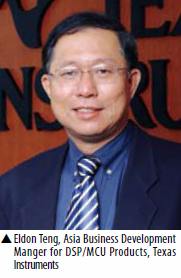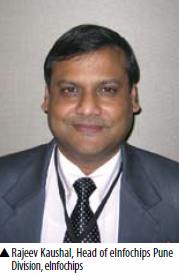Video surveillance plays a vital role in security. As the entire industry continues to migrate from analog to digital, semiconductors need to evolve as well to better cater to ever-increasing needs for higher quality and processing speeds. A&S explores the latest statistics, trends and applications in chipsets for surveillance equipment.
Video surveillance plays a vital role in security. As the entire industry continues to
migrate from analog to digital, semiconductors need to evolve as well to better cater to ever-increasing needs for higher quality and processing speeds. A&S explores the latest statistics, trends and applications in chipsets for surveillance equipment.
Most in the video surveillance industry agree that the worldwide market for security-related video chipsets will exceed US$1 billion between 2011 and 2012, similar to iSuppli's projection of $1.25 billion by 2011. According to Mike Long, Marketing Manager for Surveillance and Machine Vision Solutions, DSP Group, Analog Devices, the bulk of the business calls for use of DSPs, SoCs and ASSPs/ASICs (application-specific standard products or integrated circuits).
When looking at regional uptake, North America and Europe account for the lion's share at the moment, suggested Danny Petkevich, Video Surveillance and Imaging Business Manager, and Eldon Teng, Asia Business Development Manger for DSP/MCU Products, Texas Instruments. Figures from Altera second this observation, as Asia, Europe, North America and the rest of the world take up 20, 35, 30 and 15 percent, respectively, of the global market share.
It was predicted that Asia will catch up quickly and become dominant, though, “as the United States and Europe slow down in 2009,” said Rajeev Kaushal, Head of eInfochips Pune Division, eInfochips. This growth can be attributed to the ever-expanding OEM/ODM base in Asia, added Bengt Christensson, VP of Business Development for Stream Processors. By 2011, said Long, Southeast Asia alone could be consuming 33 percent of the global output.
Distinctions
DSPs allow for shorter time to market and offer flexibility and improved interoperability for emerging standards. There are, however, certain functions that cannot be supported by traditional, general-purpose DSPs. This can lead to time-consuming reprogramming and may result in lower performance.
 Companies such as Axis Communications and IndigoVision, on the other hand, have capitalized on ASICs. Main disadvantages of this approach, pointed out Long, are significant development cost and lack of scalability and programmability, which could detrimentally affect the marketability of end equipment due to relatively long lead times and high nonrecurring engineering expenses.
Companies such as Axis Communications and IndigoVision, on the other hand, have capitalized on ASICs. Main disadvantages of this approach, pointed out Long, are significant development cost and lack of scalability and programmability, which could detrimentally affect the marketability of end equipment due to relatively long lead times and high nonrecurring engineering expenses.
Combining ASSP/ASIC and DSP solutions is common in cases where flexibility is required, such as to enable a wider range of video analytic algorithms or different video codecs within the same platform. This is the case with some of today's intelligent cameras.
SoCs are of lower power, lower price (once developed) and bring about simpler system integration. “Targeted SoCs can include the best features of traditional DSPs and ASICs to tackle the control and signal processing tasks found within major surveillance applications with great ease,” said Long. But SoCs have limited functionality and support for new standards or differentiation; there is also little support for video analytics, and users have to rely on chipset developers completely for new features.
According to Altera, FPGAs offer parallelism not available in other fixed architectures, are fully scalable, and can be easily upgraded in the field — but with significantly higher power consumption and solution cost.
 Applications
Applications
Semiconductors used in security cameras were estimated, by Stream Processors, eInfochips, Pixim and Techwell, to have grown between 10 to 40 percent per year for the past two years. Although the macroeconomic environment for 2009 is still unclear, rendering the banking and retail sectors more susceptible than others, general consensus is that similar growth can still be witnessed in the next few years.
John Monti, VP of Marketing and Business Development for Pixim, estimates that more than 90 percent of all surveillance cameras use ASSP/ASIC solutions rather than DSP ones as “ASSPs provide the best combination of high performance, low power, high integration and low cost.” However, Johan Paulsson, CTO of Axis Communications, does not think there is a clear cut as modern ASICs are combinations of different technologies, but he believes that usage of DSPs will continue to be reduced.
In practice, ASSPs are designed using ASIC methodology and sold as standard products to multiple clients, whereas DSPs and FPGAs offer more flexible functionality but require more firmware support. Essentially, it boils down to a tug of war between flexibility and cost.
As for surveillance recording devices, Tom Krause, VP of Business Development for Techwell, quoted Mark Kirstein at Multimedia Research by saying that this application will remain the biggest, surpassing network cameras and IP encoders/streamers, because stand-alone DVRs require significantly more semiconductor material than other security applications.
In DVR applications, Krause believes there is a fairly even mix between DSPs and ASICs, with ASICs used predominately for mixed-signal video processing and DSPs for compression and analytics. Figures provided by Altera show 50, 40 and 10 percent for ASSP/ASIC, DSP and FPGA deployments by 2011. Krause cautioned, though, that overall growth in DVRs is reaching a plateau as NVRs continue to take up more share.
On the Horizon
Some noteworthy trends for video surveillance, suggested Christensson, include: network connectivity, higher resolutions, video analytics, H.264 compression/decompression, smarter codecs and remote, service-based business models.
"H.264 offers compelling, networkable, end-to-end benefits relative to earlier standards,” said Christensson, “especially in a programmable processor that allows for interoperability for the installed based of M-JPEG and MPEG-4, while simultaneously enabling preprocessing and analytics to support the next generation of smarter and more differentiated systems.”
standards,” said Christensson, “especially in a programmable processor that allows for interoperability for the installed based of M-JPEG and MPEG-4, while simultaneously enabling preprocessing and analytics to support the next generation of smarter and more differentiated systems.”
He also mentioned that even though video analysis is getting a lot of press and becoming increasingly important, sales growth to date has been hampered by costly, difficult-to-use systems. Since video analytics are software-driven and demand a lot of processing power to work well, there has not been a simple way to build ASICs, as with codecs.
"Combining codecs with analytics allows, for instance, more bits and higher resolution to be allocated to dynamic regions of interest, such as faces,” added Christensson. “Another example of integration is control of frame rates and resolutions based on robust motion detection that can track and identify objects. The latest H.264 standard, SVC, further provides scalability tools to natively support multiple streams and erosion storage, suitable for video surveillance.”
Application-specific needs are also on the rise. Petkevich and Teng pinpointed traffic management as one key niche while Axis Communications has plans to launch vertical-specific solutions for transportation and retail. Similarly, eInfochips' handheld, biometrics-based reference design with video capture, wireless connectivity, finger scanner, smart card and local storage is targeted for airports and other public sectors.
Texas Instruments' TMS320C6474 for multichannel video security and infrastructure applications integrates three cores running at 1 GHz, each on a single die, delivering 3 GHz of raw DSP performance that consumes one-third less power at one-third of the cost over discrete processing solutions. Additionally, the programmable architecture provides a framework for supporting highly differentiated functionalities, including dual streaming, video analytics, customized codecs and emerging compression standards.
Techwell's latest TW2880 HD display/recording/playback controller is hailed as revolutionary by Krause in that it is the first single-chip solution that supports 16-channel, real-time, D1 recording and playback and 20-channel display of high-resolution live and playback video. It is also the first to support HD display, recording and playback for security surveillance applications.
Features offered by Analog Devices include both data path and peripheral items such as extended instructions to its Blackfin core architecture, data path hardware blocks for scaling and overlay management, and upgraded interfaces to support the increased throughput rates associated with higher resolution video processing.
 Developers like Pixim and Stream Processors focus on making their products highly configurable via software solutions, allowing their partners to stand out from the competition in the marketplace. Pixim's Eclipse Ambient Light Rejection technology for biometric and license plate recognition was introduced in 2008. Stream Processors' Storm-1 processor delivers 224,000 MMACs of computing performance, which can be compared with traditional, high-end DSPs that deliver less than 10,000 MMACs. Storm-1 provides ASIC-level cost and performance, while still being fully programmable in the standard C language. Any resolution, codec and analytic functions can be implemented without restrictions imposed by hardwired blocks, said Christensson.
Developers like Pixim and Stream Processors focus on making their products highly configurable via software solutions, allowing their partners to stand out from the competition in the marketplace. Pixim's Eclipse Ambient Light Rejection technology for biometric and license plate recognition was introduced in 2008. Stream Processors' Storm-1 processor delivers 224,000 MMACs of computing performance, which can be compared with traditional, high-end DSPs that deliver less than 10,000 MMACs. Storm-1 provides ASIC-level cost and performance, while still being fully programmable in the standard C language. Any resolution, codec and analytic functions can be implemented without restrictions imposed by hardwired blocks, said Christensson.
Nextchip has developed touch sensors targeting both security and consumer markets. A wide array of applications in TV monitors, game consoles, cellular phones and DVR displays could potentially translate to sales opportunities, said Jin Jeong, Assistant Manager for Management Support, Nextchip.
Outlook
Given the nature of electronic security — extremely dynamic and fragmented — developers are expected to adapt quickly and to accommodate ever-changing client requirements that are generally feature-specific. Aside from these hurdles, suppliers are also facing challenges related to the transition from analog digital, lack of communication standards and bleak economic outlook.
While many are predicting that sales volumes of analog and network cameras will cross over in 2011/2012, Long believes it is still unclear whether network camera deployments will be the main driver for chipset growth. The key, he explained, hinges on when this shift occurs for the majority of deployments.
Paulsson thinks that designing ASIC components with high performance to handle security features like several parallel streams and video analytics is key to survival, but vendors also face tough decisions such as increasing silicon cost to add more processing capacity to products, said Christensson. “When designing signal processing solutions for the security surveillance segment,” said Long, “the key design challenge is striking the correct balance between programmable and fixed function elements that will ultimately provide the best solution when considering the metrics of device cost, programmability/scalability, cost of ownership/development, and end customer reuse and leverage.”
 Everybody is pegging network cameras as the main segment for growth, but convergence is taking longer than most analysts expected, clarified Krause. Some are blaming underdeveloped or unreliable network infrastructure, but Krause believes it is the uncertainty around the kind of H.264 codecs to use (baseline or main profile) plus new standards like SVC that makes it difficult to identify what the next generation really is.
Everybody is pegging network cameras as the main segment for growth, but convergence is taking longer than most analysts expected, clarified Krause. Some are blaming underdeveloped or unreliable network infrastructure, but Krause believes it is the uncertainty around the kind of H.264 codecs to use (baseline or main profile) plus new standards like SVC that makes it difficult to identify what the next generation really is.
Many developers including Texas Instruments and eInfochips are concerned about interoperability among cameras, video servers, recording/compression formats and video management software. “Texas Instruments is participating in the PSIA — this is one of the areas we're trying as a supplier to help further market,” said Petkevich. In his view, apart from pricing, another factor that is potentially slowing the diffusion rate of cameras is the knowledge base in installers. More importantly, unlike consumer electronics, a professional market like electronic security takes time to mature.
In light of the migration of analog to digital/IP and the convergence of video compression standards and video analytics, effective measures that can help tackle dynamic and fragmented market requirements include: more IP solutions, forward/backward compatibility, low BOM cost and effective partnering strategy. "The first to come out with the ‘right' package — the right pricing, servicing, recurring charges and business models to engage its partners and clients with easier system installation and sufficient support — will definitely be the biggest winner of the game,” commented Petkevich.